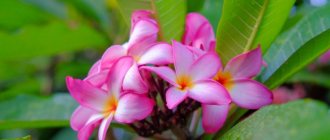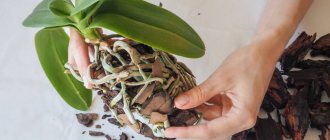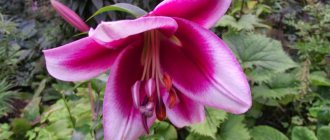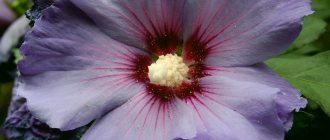Types and varieties of plants, appearance
The Japanese gladiolus flower (crocosmia, montbrecia) grows up to 60-150 cm, depending on the variety. The flowers are funnel-shaped or star-shaped, collected in a panicle inflorescence. Their color scheme is all shades of red, yellow and orange.
Flower growers have developed many (about 50) varieties and hybrids of crocosmia, which differ in the color of the inflorescences, height, time and duration of flowering. Here are some of the most popular species, varieties and hybrids:
- golden crocosmia - the species is found in natural conditions up to 100 cm high, the flowers are bright, yellow or orange, up to 4-5 cm in diameter, begins to bloom in late August - early September;
- Crocosmia massonorum is a very lush and long-blooming frost-resistant species, the flowers are small, bright orange in color, the height of the bush is 80-120 cm, with proper care it blooms from July almost until frost;
- Crocosmia Lucifer - has the brightest scarlet color of flowers, a strong, even stem, the variety is quite resistant to cold, quite tall - grows above 150 cm;
- Crocosmia paniculata - small juicy orange flowers open quite early: in late spring - early summer; quite frost-resistant and tall variety - can grow up to 120-130 cm;
- crocosmia Emily McKenzie - very unusual flowers: ocher or terracotta in color, with bright red spots in the center of each petal, plant height - up to 60 cm, begins to bloom quite late;
- crocosmia “Star of the East” is one of the most popular varieties: the plant is tall - up to 100 cm, blooms profusely and for a long time, the flowers are star-shaped, large (up to 100 mm in diameter), very rich orange;
- Crocosmia paniculata is a tall variety, up to 150 cm and above, numerous rich orange flowers begin to bloom in early summer.
Specifics of growing in open ground
An excellent solution for any area is crocosmia flowers. Planting and caring for them are practically no different from other bulbous plants.
To grow a healthy and strong plant and achieve abundant flowering, you need to know how to properly care for Montbretia.
Life cycle
As for the life cycle of Japanese gladiolus, 2 stages can be noted.
The first represents the growing season of the above-ground part. The second stage is the growth of corms.
The first stage begins at the end of April. It consists in the active growth of green mass, ending with the formation of seed plants.
The second stage begins after flowering. To grow corms, the plant requires rest.
At this time, the flower needs cooling and short-term warming.
Thus, these conditions can be ensured during storage of the bulbs, when they are in a cool basement.
In addition, under natural conditions this occurs when the tubers remain in the soil over the winter.
Every year, an adult corm produces about 5-6 children. They will bloom next year.
Choosing a landing site
An amazing plant - crocosmia. It is recommended to plant it in sunny areas.
Most plants are afraid of gusts of wind. Japanese gladiolus can be planted in any unprotected area; it is not afraid of the wind.
It is recommended to prepare the soil in advance. The soil for crocosmia is dug up and superphosphate is added.
Consumption per 1 sq. m. is approximately 35-40 g.
If the soil is too poor, you can also add potassium chloride and nitrogen.
For clay soils, adding sand is an excellent solution.
This will make the ground lighter.
Landing dates
Crocosmias are planted in open ground at different times, which depend on the climatic characteristics of the region.
It is important that the ground warms up to at least + 6-10°C at the time of planting.
This time usually falls at the end of April or beginning of May.
In this case, the planting method does not matter: whether it is sowing seeds or planting bulbs.
The grown bulbs and seedlings are planted in a permanent place in late May - early June.
At this stage it is important that there is no frost at night.
On a note! Experienced gardeners note that varieties with large flowers have poor cold tolerance. It is recommended to plant such species in open ground a little later, and also dig them up for the winter.
Planting with corms
Japanese gladiolus montbretia can be grown from bulbs. It is much faster and easier to obtain a perennial plant in this way than by sowing seeds.
In order to plant corms, you first need to prepare planting material:
- By the end of March, the corms are removed from the cellar.
- Store at room temperature for 1-2 weeks.
- Next, the corms are selected. They are cleaned of old scales.
- After this, the children are separated.
- To speed up germination, a heat treatment method is used. It involves heating the planting material in a warm solution of potassium permanganate. The solution temperature should be +40°C.
Now the planting material is completely ready.
Transfer it to the site and prepare the holes.
The distance between individual plants is left at least 12-15 cm.
Large bulbs are buried by 10 cm, small ones by 5 cm.
Important! When planting Japanese gladioli of different types, a distance of more than 70-80 cm is left between the bushes. Otherwise, cross-pollination will occur, which threatens the loss of varietal qualities of the plants.
It is important to plant the bulbs in open ground in time. If you do this too early, they may freeze, so you'll need to plant the bulbs in a pot first.
When the weather becomes warm outside, the planting material is transplanted from the pots to a permanent place.
Growing seedlings from seeds
You can also get beautiful flowers from seeds. For sowing, it is recommended to choose large containers (pots, boxes).
Soil mixture for growing crocosmia from seeds can be purchased at a flower shop or made yourself.
The latter case involves mixing peat with sawdust. The correct process for sowing seeds is as follows:
- The prepared substrate is poured into containers in a layer of 4-5 cm.
- Next, make indentations and lay out the planting material.
- Sprinkle the soil mixture on top and water it.
- Containers are covered with glass or film to create a greenhouse effect. Such conditions accelerate the process of seed germination.
- Every day, the glass or film is removed for a while to ventilate the containers. Otherwise, mold may form due to increased humidity and heat.
You can make holes in the film so you don't have to remove it all the time. It is also important to regularly monitor the condition of the soil and prevent it from drying out.
Excess moisture is also not desirable, as it can cause rotting of the root system.
It is recommended not to water the sprouts, but to spray the soil with a spray bottle. For this purpose, it is better to take warm water, at room temperature.
Seedlings can be planted in a permanent location from about mid-May.
At the same time, it is important to focus on weather conditions, since they can vary greatly in different regions of the country.
The absence of frost and well-warmed soil are ideal conditions for planting crocosmia in open ground.
Where and how does Japanese gladiolus grow?
The homeland of Montbrecia is the southern and central part of Africa, where it grows in the natural conditions of a humid subtropical climate, forming entire thickets. Therefore, planting sites should be well lit, with sufficiently moist soil.
If you dig up a plant along with a lump of earth in early autumn and plant it in a flower pot, then it will delight you with flowering on a windowsill or glassed-in balcony for more than a month.
Planting montbretia from bulbs
Chinese gladioli grow beautifully from bulbs, which need to be brought into the house before planting and separated from the overgrown children. To make the bulb more hardy, it must be treated with a solution of potassium permanganate immediately before planting in the ground.
The soil for montbretia should be loose, well fertilized with organic or mineral components. The place for planting flowers can be prepared in the fall, using sand for drainage. If desired, the soil can be neutralized from possible pathogens by treating it with a solution of potassium permanganate.
The distance from one bulb to another should be at least 10 cm. The holes can be made with a shovel or hoe; their depth should be about 4 cm. In order for Montbrecia to bloom earlier, it is better to germinate the bulb in special containers before planting. Sprouted bulbs must be planted together with the soil that is in the pot.
Despite the similarity of the plant in name and shape of the bulbs with gladiolus, Montbretia is much better than its well-known relative, since it is more resilient and easy to care for.
It does not require as much watering as a regular gladiolus and does not need frequent feeding.
Chinese gladiolus is suitable for decorating large and small flower beds. It can be grown with any other flowers - chrysanthemums, echinacea, cannas, dahlias, daylilies, where gladiolus will complement these wonderful plants and help create a unique composition in the garden.
Before buying a Chinese gladiolus, you should carefully read about the variety itself (and there are quite a lot of them), since some plants can reach a height of more than 1 meter (for example, the Montbrezia Lucifer variety, which is distinguished not only by its tallness, but also by its rich red flowers). This will require planting them not in small flower beds, where low-growing ones are suitable, but for large areas or for decorating hedges. The largest flowers are in the variety Star of the East, where the bud in diameter exceeds 9 cm.
Benefits of the plant
The only useful property of montbretia is its decorative effect. They breed it not only for beautiful flowers, but also for greenery that is pleasing to the eye. In 2-3 years, Montbrecia grows well and is used as a ground cover plant. You can plant it even in dense shade - it is unlikely to bloom there, but dense emerald thickets will decorate your site.
In addition, Montbrecia is good for bouquets - cut flowers retain their beauty and freshness for up to 2 weeks.
Japanese gladioli in garden design
Montbrecia is usually grown in large groups or in mixed flower beds. These plants look very beautiful against the background of low-growing flowers. Typically, Japanese gladioli are placed in the foreground in mixborders. These flowers look great against the backdrop of emerald green lawns, in dry gardens, against the backdrop of dense greenery of conifers, and in gravel gardens.
- Montbrecia or, also, crocosmia can be planted in natural plantings. The greenery of this plant can cover a large area in a short period of time.
- Montbrecia is very often used as a ground cover plant in gardens of impressive size. Japanese gladioli can form dense thickets in a shaded area.
- This flower looks great in bouquets. And it can last up to two weeks in a vase. Very elegant bouquets are made from Japanese gladioli and ornamental grasses. In dry winter bouquets, the plant retains the brightness of its flowers and holds its shape for a long time.
- The best partners for montbretia are perennials such as kniphofia, yarrow, rudbeckia, and echinacea.
- Lushly blooming dahlias and bush salvias look great next to Japanese gladioli.
- An excellent partner for this flower are ornamental grasses. Japanese gladioli and daylilies with their lush greenery look very harmonious in the same flowerbed.
- Montbrecias can be planted near bodies of water. In garden plots you can often see Japanese gladioli next to gazebos and recreation areas.
How to grow montbrecia, care, pests and diseases
Breeding
- You can propagate crocosmia with seeds: in February, sow them in containers and place them on a lighted windowsill. In May, the seedlings are ready to grow in open ground: replant them together with soil from the pot so as not to damage the root system. Such plants begin to bloom in the 2-3rd year.
- If you grow this plant from bulbs, then before planting, leave them for 2-3 days at room temperature, peel them from dry roots, and separate the children. To protect flowers from harmful microflora, place them in a weak solution of potassium permanganate for 2-3 hours, after which you can plant the bulbs in boxes or pots for germination, and in May - in a flower bed. Planting depth is 5-6 cm, the distance between plants is at least 10-13 cm.
- You can also plant the children of an adult plant in the fall in prepared fertilized soil no deeper than 5 cm, and the very next year Montbrecia will begin to bloom profusely.
Japanese gladiolus (photo), planting and caring for which does not create any special problems, still requires care and attention. It is best to grow it in well-lit, moderately moist areas of the garden. In heavily shaded areas, Japanese gladiolus montbretia blooms sparingly or does not bloom at all. Crocosmia grows well even on poor soils, but fertilizing, of course, will make the flowering more lush: nitrogen fertilizers, potassium mineral supplements, and a solution of cow manure in a ratio of 1:10 will be useful.
You need to water the flower infrequently, but in sufficient quantities. After watering or after rain, it is better to loosen the soil around the crocosmia, making the soil fluffy, loose, permeable for the circulation of moisture and air.
If the climate in your area is mild, then the bulbs can be left to overwinter in the ground. But the plant needs to be prepared for winter: in late autumn, cut off the stem and leaves so that the bulbs ripen better. If periodic rather severe frosts are expected in winter, then it is better to insulate the growing areas of crocosmia with a thick layer of leaves (15-20 cm) and cover with polyethylene. In the spring, after stable warming, the film and leaves should be removed.
If the winters are always long and harsh or your site is located in a low-lying area where rain or melt water stagnates, then it is better to dig up the bulbs. In mid-late September, the stem of the faded gladiolus is cut off, leaving a basal segment of 5 cm, after which the bulbs are carefully dug up, dried in a cool room, transferred to boxes with peat or sawdust, having previously disinfected them, and sent for storage at a temperature not exceeding 10 ° From the basement or cellar.
Disease and pest control
What is especially good about Japanese gladiolus is its resistance to diseases and pests. Although certain problems arise when breeding this flower. The plant especially needs to be protected during the flowering period. Improper care, excess moisture in the soil or, conversely, drought can cause disease.
Gray rot - plants are susceptible to this disease at the end of summer, when humidity rises and the temperature at night drops to 18 degrees.
Photo: © pnwhandbooks.org
After heavy rains, gray rot first affects the root collar, and then the entire tuber bulb. Over time, the middle may crumble from it, and the corm will look like a donut. The most dangerous thing is that at the initial stage of the disease, the bulb appears healthy in appearance, the color of the scales does not change. But if you touch it, it will be soft with a spongy structure inside.
Attention! It is very important to recognize the disease in time so as not to remove the infected bulb along with healthy ones for storage. Because from contact the disease will spread to them.
Signs of a diseased bulb are that it is lighter than a healthy one, and if you press with your fingers, you feel soft. If you plant a diseased bulb, the root system will not develop, germination will be weak and the flower will die. To prevent this disease, before planting and winter storage, you need to treat the bulbs with special solutions. Plant plants on a level place where water does not stagnate.
The next disease, fusarium, develops in warm and humid weather, and also if Japanese gladioli were planted in acidic, heavy soil with a low phosphorus content.
Photo: © ipmimages.org
The disease immediately infects the root system and bulbous vessels, which leads to premature yellowing of the leaves (first the lower ones, then the rest). Over time, the leaves droop and the flower looks depressed. Diseased bulbs are easily recognizable; the spots of rot have a clear boundary. The initial stage can be determined by the roots; in the affected corms they are drying out and brown.
The best prevention of this disease is a well-ventilated, drained and illuminated area. Planting should be carried out in soil heated to 7-10 degrees, do not allow it to become waterlogged or dry out.
It is also possible to become infected with jaundice, when the tips of the entire foliage turn yellow. This disease is transmitted by cycad insects. As a preventive measure, the bulbs should be soaked in water heated to 45 degrees for 20-30 minutes. Among the pests that attack the plant are thrips, mole crickets and spider mites. They are fought with pesticides and traps are placed on mole crickets.
Japanese gladiolus (Montbrecia): characteristics, features of planting and care
The Japanese gladiolus is a beautiful, sophisticated flower that looks perfect anywhere. The original name of the Japanese gladiolus is Montbrezia. The flower has a beautiful, refined shape that may resemble the shape of irises. Japanese gladiolus is famous for its resistance to weather conditions. It retains its sophisticated, fresh appearance from the first months of summer to late autumn.
In the photo showing the Japanese gladiolus, you can see flowers that look like funnels. The inflorescence usually opens at the very top. One plant can delight the surrounding world with 10 flowers from bright red to soft pink.
Planting bulbs and storing them
You can plant an adult Japanese gladiolus bulb right away. The bulbs are planted to a depth of about 5-6 cm. The distance between plants should be at least 12 cm. In spring, when the air and soil warm up, you can begin to plant the bulbs in the flowerbed.
Before planting, the bulbs should be kept in a weak solution of potassium permanganate for several hours, and then planted in a container for germination. Only in May should the sprouted bulbs be planted in open ground.
Japanese gladiolus bulbs in regions with harsh climates must be dug up. They begin digging the bulbs after the foliage turns yellow. This time usually falls in mid-September. The stem is carefully cut off, leaving only about 5 cm at the roots. Then the bulbs, which may contain children, are dried in a cool room and placed in wooden boxes with dry peat. Before spring planting, the bulbs must be brought into a warm room in March, separated from the bulbs, peeled, and trimmed off old, dry roots.
Montbrezia in a bouquet
When creating a bouquet with Montbrezia, it is good to add golden color, for example, cereals. They will make the flower look even more elegant and sophisticated. In a bouquet, Montbrezia lasts up to 4 weeks. During this period, she will completely reveal her buds to the world. Cutting Japanese gladiolus for a bouquet is very useful for the further growth of flower bulbs. For those who do not want to part with a beautiful flower, we can advise you to dry it for the winter for a dry bouquet. It will preserve the color and shape of the flowers.
Preparing Japanese gladiolus for winter
Once the inflorescences have completely faded and withered, cut them off to allow the bulbs to ripen better. Do not throw away the cut flower stalks, you can hang them down with a flower, dry them and then form winter bouquets; they retain their color and shape for a long time.
Most varieties of Japanese gladiolus do not overwinter in open ground; the bulbs must be removed from the ground. They must ripen completely, so do not dig them too early (in September), do it in the second half of autumn (October, November). If the bulb is not ripe, it may not survive the next season.
For the procedure, choose dry weather. Remove stems and leaves from dug up plants, leaving a small stump (5 cm). Do not cut off the roots, shake off the soil and dry for a couple of weeks in a dry room (barn). For frost-resistant flowers, cut off the stems at ground level and add a layer of straw or sawdust (20 cm). If the region is cold, then cover the top with spruce branches or film. When the bulb overwinters in the ground, the plant then becomes powerful and strong, blooms longer and more abundantly.
What to remember when growing
Planting Japanese gladiolus is simple and straightforward even for a novice gardener. For planting you will need Montbrecia seeds or “babies” of an already grown plant. The most suitable time for planting is autumn. It is best to plant about 5 cm deep. Next year you will be delighted with beautiful flowers. If you prefer to plant Japanese gladiolus in seeds, it is better to do this in February. The seeds are brown with a reddish tint and very large in size. They ripen in small oval-shaped containers.
If you plant Japanese gladiolus from seeds, it will bloom only 2 years after planting.
Montbrecia is quite prolific, it has many “babies” that turn into flowers after a year. It must be taken into account that the plant grows quickly and forms colonies. If the plant becomes denser, its flowering becomes worse and may even stop altogether. For harmonious growth, flowers should be planted once every 4-5 years in early spring before flowering begins. Using children to propagate the flower is the most optimal way to spread Montbrecia on the farm.
In May, when the earth has warmed up sufficiently, corms can be planted in the ground to a depth of 7 to 10 cm, while the corms should be located at a distance of approximately 11-12 cm from each other. It is most favorable for seeds if the soil is prepared in advance in September - October and will be fertilized.
In order for the plant to decorate the area, it is recommended to plant it in large portions in 1-2 rows of the flower garden. It is also allowed to plant on the territory of a plot located in the shade. Montbrezia tolerates its neighborhood well. Ideal neighbors for the plant would be dahlias, chrysanthemums, echinacea, daylilies, sedums, cannas, rudbeckia and other plants that bloom in the summer months.
Planting Montbrecia
Montbrecia can be planted in two ways:
- bulbs;
- seeds.
Planting with bulbs
For planting, you should choose medium-sized bulbs. If the diameter of the bulb is more than five centimeters, it is old and is not recommended for planting. The husks are removed from the bulbs, then kept in a warm place for several days to dry them. Two hours before planting, they are placed in a solution of potassium permanganate. It is better to prepare the soil in the fall. The beds are dug up and superphosphate fertilizer is applied (35 grams per 1 sq. m of bed). If the soil is poor in nutrients, it is necessary to add additional potassium chloride and nitrogen. Add sand to clay soil.
Planting in open ground is carried out in the spring, no later than the beginning of May. It is necessary to check the soil temperature, it must be at least +5°C.
A mixture prepared from compost, sand and peat is placed in each hole. The substances are mixed in equal proportions. You should get a 15 centimeter layer. Onions are placed on it, which are sprinkled with sand and earthen mixture on top. Planting is done to a depth of about ten centimeters when using large planting material, 5 cm if the bulbs are small. Be sure to maintain a distance between the bulbs of about ten centimeters, and when planting different varieties of plants - about 80 cm.
Planting seedlings
At the beginning of spring, the seeds are soaked in water for a day, changing the liquid every six hours. Then they are sown in leaf soil mixed with sand, humus with the addition of peat, at intervals of 2 cm. The container with the seeds is covered with film and placed in a bright place. After the first shoots appear, the film is removed. As the soil dries, it is necessary to water the seedlings and lightly loosen them. You need to make sure that the soil is not too wet.
Picking is carried out after two leaves appear on the sprouts. Before planting in open ground, seedlings must be regularly taken out into fresh air for 14 days for acclimatization. Seedlings need to be planted in spring. Small holes are made in the ground, no more than 7 cm deep. The sprouts, together with a lump of earth, are placed in the hole, and the soil around is compacted. Flowering of plants grown from seeds can only be expected after a couple of years.
Simple or complex care
Planting and caring for Japanese gladiolus is not difficult. Japanese gladiolus is a plant that normally tolerates low temperatures and does not get sick. All it requires is regular watering, loosening the soil and fertilizing. They must be done once every 2 weeks until flowering. Montbrecia loves light, mineral fertilizers and moist soil. It is important to remember that water in the soil should not stagnate, otherwise the plant will die. Flowers will open better if there is a large space filled with light around the plant.
If the plant has large flowers, it must be protected from low temperatures; if the plant is in a cool place, the wilted leaves should be left. It’s better not to rush into digging. If autumn is warm and frosts are delayed, it is worth postponing activities until the end of October - beginning of November.
The plant with small flowers is sensitive to temperature. To avoid trouble, it is better to cover with straw or dry leaves in a large layer of at least 18 cm, additionally placing a waterproof cover on top. This is especially necessary to do for flowers planted for the first time.
If the plant has endured the winter well, it will bloom quickly and will delight you with flowers for a long time. If the plant is planted in the south of Russia, such measures will not be required. In winter, the temperature there is suitable for overwintering the flower.
Basic rules for caring for Japanese gladiolus:
- regular watering;
- loosening the soil;
- feeding on a regular schedule;
- Thorough protection from low temperatures and snow.
In autumn, a variety with large flowers is worth digging up. In order to preserve planting material, it is necessary to trim the leaves and stems and lightly dry the corms for 2-3 days. If the bulb has spots and is soft, it is best to throw it away. Good bulbs can be kept in flower boxes wrapped in paper, the temperature should be 5-7 °C.
For some, the color and height of the planted flower is of great importance. Japanese gladiolus has different varieties that differ in flower color and size.
You can choose from:
- Crocosmia Potsa - pale pink color, height 1 m;
- Crocosmia "George Davison" - amber color, height up to 80 cm;
- Crocosmia masoniorum - orange color, height up to 1.5 m;
- Crocosmia Babylon - orange color, height up to 50 cm.
Growing flowers is always interesting and fun because you never know what will happen and when. It happens that a flower begins to bloom at the most unexpected moment, and then you become very happy that it bloomed thanks to your care and care.
Features of care
Gladiolus is not a very demanding plant, so no special gardening skills are required to care for it. As with other flowers, a full range of agrotechnical practices is needed - timely watering, weeding, loosening the soil, hilling, feeding and, if necessary, treating with pesticides against pests.
Watering rules
It is very important to provide the gladiolus with timely and moderate watering.
Overmoistening should not be allowed, as it will lead to rotting of the bulbs. Also, excessive drying of the soil is unacceptable, in which case the buds will begin to wither and fall off.
Adjust watering based on regional climate and weather conditions. Before watering, first assess the condition of the soil; it should be slightly moist. If it rained the day before, perhaps this moisture will be enough.
Loosening the soil
To make gladioli grow better, ensure good air circulation in the area. Regularly and shallowly loosen the soil around the plants, only carefully so as not to harm the bulbs.
Tying up Japanese gladiolus
Tall gladioli, when they produce peduncles, must be tied up, because the weight of the flower may bend or break the stem.
If the flowers are single, you can install supports nearby and tie them to them.
Once the plants are planted in a row, place stakes at both ends (for a very long row, another can be placed in the middle). Their height should not be lower than the gladioli themselves. Stretch the twine between the sticks and tie the plants to it.
If the flowers are very tall, then stretch two rows of twine - in the middle of the pegs and almost at the very top. In cases where there are a lot of colors, it is better to make a structure from slats.
Feeding and fertilizing
Montbrecia loves fertile and fertilized soil, so feed the plant.
- In the spring, before the gladiolus blooms, you will need a complex of mineral fertilizers (3 g per 1 liter of water). Do this feeding twice a month.
- During the ripening period of the buds, feed with potassium fertilizers (average calculation: 2 g per 1 liter of water).
- During flowering, water the flowers with mullein infusion twice a month (dilution ratio 1:10).
Chinese gladiolus: photo, planting and care
Chinese or Japanese gladiolus, also known as montbretia or crocosmia, is a beautiful and unpretentious plant that will decorate any garden. The main advantage of this unusual plant is that it blooms from early summer to late autumn, depending on the variety. The variety of shades is also impressive. Crocosmia can bloom with bright scarlet, yellow or orange flowers. However, in order for gladiolus to take root well and please with its unusual appearance, it must be planted following certain rules. The same goes for care.
Caring for Montbrecia and group plantings
Montbrecia is practically no different from other bulbous plants in terms of caring for group plantings. But, it must be constant and designed to control the level of soil moisture. Swampiness leads to the fact that the root tubers begin to rot severely and die. An infective bulb quickly transfers the fungus to other planting material, as a result, group plantings lose their decorative properties and rot completely.
Montbrezia is very fond of nutrients. It quickly consumes them from the soil, so in the summer season you need to periodically feed the plantings with mineral fertilizers. Also, you can alternate the compositions with watering the plant with a solution of bird droppings or sour mullein. In warm regions, where there is no need to prepare Montbretia for wintering in separate containers indoors, you need to water the plants with potassium solutions.
Despite the fact that crocosia is often planted on ventilated hills without protection, it is recommended to tie flower stalks to vertical poles. To ensure that your plantings have enough nutrients in the soil, prune the inflorescences at the beginning of flowering and after the buds begin to fade.
Description
The birthplace of crocosmia is not in China, but in South Africa. The plant belongs to the iris family. "Crocosmia" in Greek means "saffron scent" as its dried flowers smell of this noble spice. And the garden Chinese gladiolus was bred by Lemoine, a breeder from France. Sometimes the plant is called Chinese gladiolus.
Japanese gladiolus is characterized by star-funnel-shaped flowers, collected in the form of multi-colored spikelets. Crocosmia looks great not only in the garden, but also in cut form. Flowers can stand in a vase without losing their charm for up to two weeks. Crocosmia looks great combined with a sprig of asparagus. Winter bouquets made from dried montbretia are unusual and original.
Description of the species
South Africa is considered the homeland of Japanese gladioli. The corm hybrid was obtained as a result of experiments on crossing two varieties of crocosmia. Montbrecia is from the Iris family, although it looks more like gladiolus.
The plant has narrow leaves with pointed tips that resemble swords. Peduncles are thin, up to 1.5 meters high. At the beginning of July you can see the first flowers. They bloom one by one and delight flower growers until September. They can be painted in any color: from white to bright scarlet.
Reproduction methods
There are two standard methods for propagating Montbrecia.
Sow the seeds in February-March, placing the pots in a well-lit place. By May, the crocosmia grows up, and it can be planted in a bed with a lump of earth to better take root. If you are going to plant crocosmia in pots, then this can be done in April. Naturally, gladioli from seeds will not bloom immediately. Flowers appear in the second or third year.
Immediately before planting the bulbs in the soil, they need to be kept in a warm room for 2-3 days. About 2 hours before planting, you need to soak the bulbs in a pale pink solution of potassium permanganate. The planting depth is 5 cm.
The bulbs are planted at intervals of 10 to 12 cm. To get flowers faster, plants grown in pots are planted.
Japanese gladioli grow well in lighted areas with low groundwater. It is important that rainwater does not stagnate on the site. If you plant Montbrecia in a poorly lit area, it may not bloom.
Choosing a place to grow
In order for Montbrecia to bloom and grow well, a well-lit place is suitable. You can plant the plant in an area where the sun appears only during one half of the day. The main thing is that no shadow falls on the flower in the morning. If there is not enough light, the plant will stretch out and there will not be enough flowers. Without access to sunlight, Montbrecia will not bloom.
The planting space should be open; it is better if there is a lawn nearby. Crocosmia is quite spreading. Usually the inflorescences hang over the ground, so they need a lot of space. It is recommended to step back from the path at a distance of about 50 centimeters.
Drafts must be avoided. Cold winds should not blow on the flowers, but good air circulation is necessary. Lowlands where melt and rainwater collect are not suitable for Montbrecia. Stagnation of moisture for this plant can be disastrous. The plant is considered to be drought-resistant, but it should not be allowed to dry out too much.
You may be interested in: Byzantine Gladiolus, planting and caring for a garden beauty
Growing Montbretia in loose acidic soils is effective. It is better to plant different varieties of crocosmia away from each other so that they do not cross-pollinate, losing their qualities.
How to grow gladioli
Chinese crocosmia does not need frequent watering. After watering or rain, the soil must be weeded and loosened. Nitrogen mineral fertilizers accelerate the growth of Japanese gladiolus. In the summer, you can use a solution of mullein in a ratio of one to ten. Organic fertilizers can be used in parallel with potassium mineral supplements.
In late autumn, when the gladiolus has completely faded, the stem must be completely cut off. This is done for better ripening of the bulbs. This measure helps the corms to successfully survive the winter in the soil. If the region has a harsh climate, then the bulbs need to be dug closer to the onset of winter cold.
Store planting material at a temperature not exceeding 10 degrees, avoiding drying out. Corms are stored well in a wooden box with sawdust. You just need to first check that the sawdust is not affected by wood-boring beetles. To prevent the bulbs from drying out, they are pre-moistened with a spray bottle. In warmer climates, the bulbs overwinter in the soil. If, according to forecasts, the winter is cold, then the tubers are covered with a 20-centimeter layer of leaves, and on top of them - polyethylene. This protects the bulbs from freezing the soil. In the spring, all that remains is to remove the film and rake the leaves.
The plant is resistant to diseases, it is not difficult to grow, but pests like thrips and mole crickets are dangerous for it. Therefore, if you want to have beautiful, healthy and undamaged plants on your site, destroy them.
Harvesting and storing bulbs
Dig up planting material before the onset of frost. The longer the bulb lies in the ground, the more nutrients it will absorb. Cleaning is carried out in dry weather. The corms are dried thoroughly, otherwise they may rot in the winter. Store them in a dry, cool basement equipped with good ventilation. During the winter, the bulbs need to be inspected, discarding the rotten ones. One corm infected with pathogenic microorganisms can infect the entire planting material.
Overview of common varieties
The most popular varieties of crocosmia are as follows:
EmilyMcKenzie
Ornamental plants with brownish-orange flowers collected in a symmetrical spike. There are red spots in the center of the petals. The height of the plant is 60 cm. Gladiolus blooms late.
3
Norwich Canary
60 cm plant with yellow buds.
"Star of the East"
This variety is considered one of the most popular among Montbrecias, due to its unusually large and beautiful flowers. The bud is orange in color and has a star-shaped shape. Its diameter is about 10 cm. The plant is tall. Its height is about 1.0 m.
Lucifer
This variety is rightfully considered the brightest. The flowers are very beautiful, bright scarlet in color. The plant is tall (it happens that it has grown about 1.5 m), with a stable, erect stem.
Paniculata crocosmia
The variety is distinguished by early flowering (the first flowers appear in June). The plant blooms very profusely, with bright orange flowers.
Description of the plant
The plant is called crocosmia (lat. Crocosmia) or montbretia. Like gladiolus (swordweed), it also belongs to the Iris family, but to a different genus. This flower is often used in landscape design because it is easy to care for, has a long flowering period and an attractive appearance. During the flowering period of the plant, it is decorated with small, delicate and beautiful star-shaped flowers. Their diameter is 5 cm. Crocosmia panicles are similar in appearance to iris. The plant blooms from July until September - October.
Did you know? In antiquity, the sharp leaves of gladiolus evoked associations with weapons, so its tubers were considered amulets that could protect a warrior from death.
The flower smells pleasant, not intrusive, vaguely reminiscent of saffron. The corms of the plant are small, covered with three layers of protective peel. One bulb produces three flower stalks. The root system consists of two tiers. The first represents the roots of the mother bulb, and the second grows between the planting and replacement bulbs. The leaves grow up to 60 cm in length, having a sword-shaped shape. The stem is branched and thin; growing, reaches 1.5 m.
Preparing Chinese gladiolus bulbs for planting
- In the spring, after storage, it is necessary to inspect all the bulbs. First of all, check them for rotting, which can cause damage to the flowers. Also inspect the tubers for dry rot. Such bulbs cannot be planted, otherwise the disease will spread to other plants in the garden. Damaged material must be disposed of.
- Peel the selected large bulbs from the top layer of scales, leaving the thinnest upper part. Work carefully so as not to damage the eye and roots. Children must be separated immediately after digging and stored separately from large tubers. Tuberbuds of Chinese gladiolus differ from mature bulbs in the presence of a dense shell. It must be completely removed, since the sprout may not break through it. To do this quickly, press the bulb with your fingers on both sides until it clicks, then remove the scales.
- Immediately after this procedure, it is necessary to treat the tubers, since various pests can overwinter under the outer shell. Soak the peeled onions in a strong solution of potassium permanganate for 1 hour. Or use insecticides and fungicides according to package directions.
- To obtain strong plants and abundant flowering, the tubers must be germinated. This must be done 2 weeks before the planned disembarkation date. Babies need to be delivered only 7 days before planting. Due to their small size, they have little moisture inside, which can cause the bulbs to dry out prematurely.
- Prepare a flat tray, even a spread will do. Place sawdust on the bottom or cover it with paper. This will prevent possible damage to the roots during germination or planting of tubers in the ground. Arrange the bulbs in one layer, but so that they do not touch each other.
- Place the container in a well-lit place with low humidity and always warm. There is no need to additionally moisten the tubers until planting. After 2 weeks, inspect the sprouts. If there are several weak shoots around a strong shoot, then remove them. This will give the opportunity to develop a powerful peduncle. You should also throw away any bulbs that haven't sprouted at all.
- Repeated disinfection of tubers must be carried out on the day of planting. Immerse the planting material completely in a weak solution of potassium permanganate, dilute 1 gram of it in 10 liters of water. Leave the planting material in the solution for 1 hour. Then take it out and let it dry.
- After this comes the time for growth stimulants. Prepare the product, pour it into a shallow container and dip the bottoms of the onions. Complete immersion of the tubers is not required. It is necessary to soak the tubers for 10-12 hours, unless otherwise indicated in the instructions. The finished material should be planted immediately.











